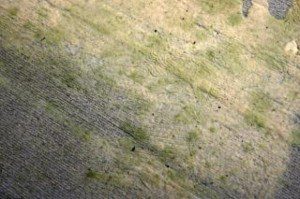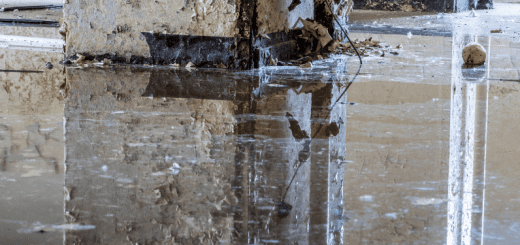How to Recover From Flood Damage
Midwinter vacations are a great way to beat cabin fever, but nothing ruins that happiness faster than coming home to a wading pool in your house. It’s vital to start the cleanup as quickly as possible to limit the damage and prevent dangerous moldMold is a type of fungus that grows in damp or humid conditi... More. These tips from the Federal Emergency Management Agency (FEMA) will help keep the damage to a minimum.
What to Do in case of Flood Damage
1. If any wiring is wet or moldy, turn off the main power and don’t turn it back on until it’s been checked by an electrician.
2. Open the windows to let in fresh air and use fans and dehumidifiers to dry and remove moisture.

The effects of flood damage in a carpet.
3. If moldMold is a type of fungus that grows in damp or humid conditi... More has already started to grow, don’t use fans; they’ll spread it.
4. If any ductwork for the central heating/air came into contact with water, don’t use them until they’ve been checked by a professional.
5. Remove wet items like furniture, clothes, and toys, and throw away wet or moldy carpet. Other items can be cleaned and disinfected.
6. Food products that came into contact with floodwater should be thrown away unless they were stored in watertight containers.
7. Remove wet or contaminated materials like ceiling tiles, drywall, and wood by-products.
8. If drywall is soaked, remove to a foot above the watermarkA watermark is a visible stain or discoloration left on surf... More and discard. Drain water out of the walls by removing the baseboards and drilling holes near the floor. Panel-type walls can be drained by pulling the bottom edge out from the studs. Be sure to check the interior of the wall for hidden moldMold is a type of fungus that grows in damp or humid conditi... More. Remove all wet insulationInsulation is a material used in buildings to reduce the tra... More and discard all but rigid insulationInsulation is a material used in buildings to reduce the tra... More. Rigid insulationInsulation is a material used in buildings to reduce the tra... More can be reinstalled after disinfecting and dryingDrying is the process of removing moisture from materials, s... More.
Call a Flood Damage Restoration Company
If your home or business falls victim to a flood, call the certified technicians at RestorationMaster. They’re on call 24 hours a day, seven days a week so they can immediately respond and limit the damage. Their technicians can clean up the aftermath of burst pipes and other water related emergencies quickly before hazardous mold and mildew set in. They will also assess and document the damage before extracting the water with techniques best suited to the situation.












